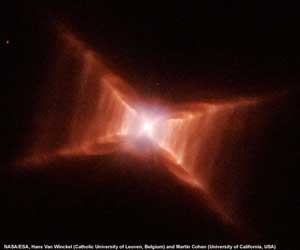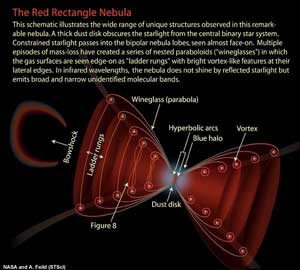|
 Imagine
smoke rings seen edge on and you may gain some insight
to what's going on with the deceptive Red Rectangle, which
isn't a rectangle at all. Imagine
smoke rings seen edge on and you may gain some insight
to what's going on with the deceptive Red Rectangle, which
isn't a rectangle at all.
The optical illusion is the work of a
pair of stars that orbit one another and have created
a strange series of emissions over thousands of years.
The periodic outflows have expanded into space to create
circular rungs on two imaginary cones, but we see them
from the side rather than as if looking into the mouths
of the cones.
The emissions are paired, going in opposite
directions, creating a structure something like giant
megaphones set back-to-back.
New details of the strange nebula emerge
in images from the Hubble Space Telescope, released today.
Not rectangles
 The
structure is called a planetary nebula, not because it
has anything to do with planets but because in primitive
telescopes the class of object looked something like the
fuzzy disks of the gas giant planets in our solar system.
Catalogued as HD 44179, this nebula is about 2,300 light-years
away. The
structure is called a planetary nebula, not because it
has anything to do with planets but because in primitive
telescopes the class of object looked something like the
fuzzy disks of the gas giant planets in our solar system.
Catalogued as HD 44179, this nebula is about 2,300 light-years
away.
The Red Rectangle was named by Martin
Cohen and Mike Merril in 1973 because of its appearance
on old photographic plates. The name stuck, but the two
lobes billowing out into space don't really fit the moniker
any longer.
"They're not rectangular," said
Cohen, of the University of California, Berkeley, in an
e-mail interview over the weekend. "They're 'wineglasses'
placed bottom-to-bottom with the star where the bottoms
would make contact. Across these outside curves are strands
like a ladder of nebulosity crisscrossing the interior
of the glasses."
Yes, it's complex. And only now are astronomers
starting to figure out what created the bizarre shape.
Cohen worked with Hans Van Winckel of the Catholic University
of Leuven, Belgium, and other researchers to obtain the
new Hubble picture. It shows for the first time new structures
that may explain how the whole setup came to be.
The secret
"The secret of the Red Rectangle
is that it is a double star," said Van Winckel, who
led the effort.
At the center of the nebula, two stars
orbit each other every 10.5 months. The more massive star
is running out of fuel and swelling into what astronomers
call a red giant. Our Sun will do the same in a few billion
years, and the hot sphere will swell unimpeded beyond
the orbit of Mars, vaporizing all the inner planets.
Inside the Red Rectangle, the main star
ballooned to a point where gravity from the companion
star began to siphon material from it, Van Winckel speculates.
This effect created a donut-shaped disk of dust, called
a torus, that orbits both stars. Now the main star is
in a new phase, losing more mass. But this mass can't
just flow in all directions. It is funneled in two directions,
above and below the donut but not through it.
"That is why we see the double cone,"
Van Winckel told SPACE.com. "So it is the presence
of that companion, with its given orbital characteristics,
that made the Red Rectangle the way we see the object
now."
Spurts of activity
The emissions are not continuous, but
instead occur in bursts every few hundred years, creating
the rung-like structure of the nebula.
The red emissions are a result of photoluminescence,
in which molecules are excited to glow by light energy
(as opposed to just reflecting light). Astronomers don't
yet know what gas molecules, or possibly small dust particles,
create the color.
Cohen calls the Red Rectangle an "outlier"
that by its very strangeness could help astronomers figure
out how other nebulas form from dying stars. "The
Red Rectangle has become a kind of touchstone in that
it embodies several mysteries," he said. "Its
stunning geometries are just one facet."
The Hubble observations are expected to
help the researchers learn more about how binary star
systems develop, especially in the late stages, something
that's not well understood,
"The Red Rectangle shows that we
still are far from understanding everything," Van
Winckel said.
|